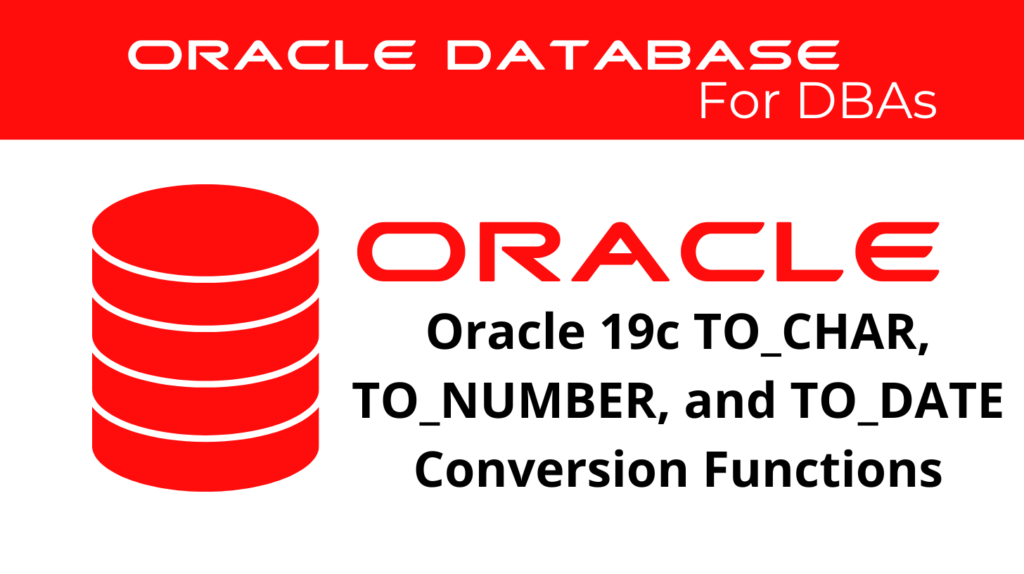
When working with Oracle databases, understanding and utilizing Oracle conversion functions effectively can greatly enhance data handling capabilities. These functions, TO_CHAR, TO_NUMBER, and TO_DATE, allow seamless transitions between data types. This tutorial provides a comprehensive guide to these conversion functions and their applications in Oracle 19c. Additionally, mastering formatting functions Oracle ensures precise control over data representation.
Why Oracle Conversion Functions Are Essential
Oracle conversion functions play a vital role in transforming data into usable formats. Whether it’s converting numbers to characters or dates to numbers, these functions ensure data consistency and adaptability. By mastering Oracle conversion functions, database administrators and developers can efficiently handle complex data transformation requirements.
Key Benefits of Using Oracle Conversion Functions
📢 You might also like: Oracle Table Joins: Displaying Data from Multiple Tables Using Joins (Category: Oracle Database Admin)
Enhanced Data Compatibility with Oracle Conversion Functions
Data stored in databases often requires conversion to match application requirements. With Oracle conversion functions, such as TO_CHAR, data becomes more flexible and adaptable for various use cases. This is where data type conversion comes into play, allowing seamless integration across different systems.
Streamlined Data Formatting Using Oracle Formatting Tools
Formatting numbers and dates accurately is crucial for reports and data visualization. Tools like TO_NUMBER and TO_DATE simplify this task by offering predefined format masks. These Oracle formatting tools ensure consistency and readability in outputs.
TO_CHAR Function: Converting Data into Readable Formats
The TO_CHAR function is a cornerstone of data type conversion in Oracle. It transforms numeric and date values into string representations, enabling better readability and integration.
How TO_CHAR Handles Numbers
By applying numeric format masks, TO_CHAR allows precise control over the representation of numeric data. For example:
SELECT TO_CHAR(1234.56, '9999.99') AS formatted_number FROM dual;In this query, the number 1234.56 is formatted to display exactly two decimal places, ensuring uniform representation across reports.
Advanced Example:
SELECT TO_CHAR(98765.4321, '$999,999.99') AS formatted_currency FROM dual;This formats a numeric value into a currency representation, useful for financial reporting.
Converting Dates to Strings
Date formatting is another powerful feature of TO_CHAR. The function can produce outputs like:
SELECT TO_CHAR(SYSDATE, 'YYYY-MM-DD') AS formatted_date FROM dual;This query converts the system date into a standardized string format for easier readability and usage in external systems.
Additional Examples with TO_CHAR
SELECT TO_CHAR(SYSDATE, 'fmDay, ddth of Month YYYY') AS formatted_date FROM dual;This example highlights how to include day and month names in the formatted output, improving the clarity of reports.
SELECT TO_CHAR(567.89, '999.99') || ' units' AS inventory FROM dual;Combining formatting with string literals can make data outputs more informative.
Oracle Conversion Functions – TO_NUMBER: Ensuring Numeric Precision
The TO_NUMBER function is indispensable for converting string data into numeric formats, especially when dealing with user input or imported data.
Handling Currency and Special Characters
By applying specific format masks, TO_NUMBER processes strings containing symbols like dollar signs or commas:
SELECT TO_NUMBER('$1,234.56', '$9,999.99') AS numeric_value FROM dual;This query extracts the numeric value from a formatted string, ensuring it can be used in calculations.
Additional Examples:
SELECT salary + TO_NUMBER(bonus, '9999.99') AS total_salary FROM employees;This demonstrates how TO_NUMBER integrates seamlessly with arithmetic operations.
SELECT TO_NUMBER('00123', '99999') AS cleaned_number FROM dual;This query removes unnecessary leading zeros from a string.
TO_DATE Function: Simplifying Date Handling
The TO_DATE function is tailored for converting strings into date formats, ensuring consistency in date storage and manipulation.
Using Format Masks for Accuracy
By specifying format masks, TO_DATE converts strings accurately into date objects:
SELECT TO_DATE('2025-01-01', 'YYYY-MM-DD') AS converted_date FROM dual;Additional Examples with TO_DATE
SELECT TO_DATE('31-DEC-2023', 'DD-MON-YYYY') AS new_year_eve FROM dual;This converts a specific date string into an Oracle date type.
SELECT TO_DATE('20230131 15:30:45', 'YYYYMMDD HH24:MI:SS') AS timestamp FROM dual;This includes both date and time components, showcasing the flexibility of TO_DATE.
Complex Example:
SELECT employee_id, TO_DATE(hire_date, 'YYYY-MM-DD') AS start_date
FROM employees
WHERE TO_DATE(hire_date, 'YYYY-MM-DD') < SYSDATE;This example filters employees hired before the current date.
Practical Use Cases for Oracle Conversion Functions
Data Formatting in Reports
Combining conversion functions with aggregation and filtering techniques allows for highly customizable reports. For instance:
SELECT department_id, TO_CHAR(SUM(salary), '$999,999.99') AS total_salary
FROM employees
GROUP BY department_id;This query calculates total salaries per department with formatted outputs.
Validating User Input
Ensuring that user-provided data is in the correct format reduces errors:
BEGIN
DECLARE valid_date DATE;
BEGIN
valid_date := TO_DATE('2025-12-31', 'YYYY-MM-DD');
END;
END;Dynamic Queries
Dynamic queries can leverage conversion functions for flexible operations:
SELECT employee_name || ' started on ' || TO_CHAR(hire_date, 'Month DD, YYYY')
FROM employees;This produces a human-readable string combining text and formatted dates.
Best Practices for Using Oracle Conversion Functions
- Avoid Implicit Conversions: Relying on implicit conversions can lead to errors. Use explicit functions like TO_CHAR, TO_NUMBER, or TO_DATE to ensure predictable outcomes.
- Leverage Format Masks: Proper format masks simplify complex conversions and improve data integrity.
- Test Conversions Thoroughly: Before implementing conversion logic in production, test all edge cases to avoid runtime errors.
Conclusion: Mastering Oracle Conversion Functions
Understanding Oracle conversion functions is essential for efficient database management. Functions like TO_CHAR, TO_NUMBER, and TO_DATE provide the tools needed to manage data seamlessly in Oracle 19c. By applying the concepts and examples outlined in this tutorial, users can enhance their database operations and achieve greater efficiency in data handling. Additionally, leveraging formatting functions Oracle ensures precision and consistency in all database activities.
See more on Oracle’s website!
Be Oracle Database Certified Professional, this world is full of opportunities for qualified DBAs!





